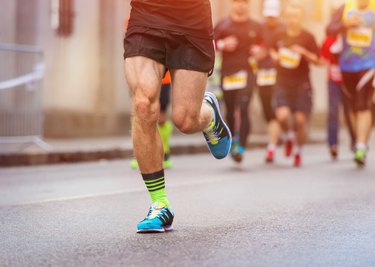
When your muscles get out of balance and one becomes stronger than its opposing set, it can put you at risk for injury. Two of your biggest leg muscles, the hamstrings and quadriceps, oppose each other on the front and back of your thighs. If one is stronger than the other it can put you at risk for a knee injury, like an ACL tear. Balance them by strengthening the weaker muscle set with resistance exercises.
Quad and Hamstring Anatomy
Video of the Day
Your hamstrings are the muscles at the back of your thigh. There are four hamstring muscles, and they start at the bottom of your hip bones and run into the top of your shins. The hamstrings bend your knee and extend your leg back.
Read More: Hamstrings Vs. Quads
The quadriceps are also made up of four muscles. Three of them run from the top of your femur down into your knee cap. The fourth muscle starts at the front of your hip and also runs over the kneecap. There the muscles turn into the patellar tendon, which engulfs the knee cap and goes down into the front of your shin. The quads straighten your knee.
When Leg Muscles Become Imbalanced
One of the most common knee injuries is an ACL tear. The ACL, or anterior cruciate ligament, connects your thigh bone to your shin bone. Usually, people who tear it have much stronger quads than hamstrings. The quads pull the knee forward and if the hamstrings aren't strong enough they can't pull it back, then the ligament tears.
Another common injury from having strong quads but weak hamstrings is a hamstring injury while running or lifting weights. If you tear, pull or strain your hamstrings it might be because they were too weak.
Fixing Quad and Hamstring Imbalance
Most people have relatively even quadricep-to-hamstring ratio of strength. If these muscles are imbalanced it's usually the quadriceps muscles that are stronger. An even hamstring to quadriceps ratio is considered .75, meaning for every 4 pounds the quads can lift the hamstrings can lift 3 pounds.
Read More: Quad & Hamstring Strengthening Exercises
That means that if you have an imbalance, you're probably going to have to work on your hamstring strength.

Sliding Hamstring Curl
One of the best exercises to target hamstring strength is the sliding hamstring curl. It's safe and forces the hamstrings to work.
How to: Lie on your back with your legs straight. Put sliders or towels under your feet if you're on a hardwood floor or other smooth surface. Pull your heels in towards your butt and, at the same time, lift your hips up. Keep pulling until your heels are under your knees and your butt is in the air. Then, extend your legs out and drop your butt to the ground, returning to the start position.
Machine Leg Curl
The leg curl exercise allows you to isolate and strengthen your hamstring muscles.
How to: Sit in the leg curl machine with your back flat against the chair. Your legs should be straight out with the pad under the bottom of your calf muscle. Pull the pad down towards your butt as far as you can, then slowly raise your legs back to the start position.
Machine Leg Extension
While the hamstrings tend to be weaker than the quadriceps, sometimes the quads are actually weaker. This could be due to surgery or injury, but either way you should strengthen them with this isolation exercise.
How to: Sit in the leg extension machine with your back flat against the back of the chair. Set the pad right at the bottom of your shin bone. Your legs should be bent as far back as is comfortable. Extend your legs out straight against the pad until your knees are locked out, then slowly lower them back to the start position.
- Journal of Athletic Training: Isokinetic Hamstrings:Quadriceps Ratios in Intercollegiate Athletes
- University of North Florida: Isokinetic Hamstring: Quadriceps Strength Ratio in Males and Females: Implications for ACL Injury
- PLOS One: Influence of Anterior Cruciate Ligament Tear on Thigh Muscle Strength and Hamstring-to-Quadriceps Ratio: A Meta-Analysis
- Clinical Journal of Sports Medicine: The Relationship of Hamstrings and Quadriceps Strength to Anterior Cruciate Ligament Injury in Female Athletes
- Journal of Sports Sciences: Angle-specific hamstring-to-quadriceps ratio: A comparison of football players and recreationally active males
- British Journal of Sports Medicine: HAMSTRING/QUADRICEPS RATIO IN ACL INJURY PREDICTION IN ELITE FOOTBALL PLAYERS